At the beginning of Act II of Delibes’ tale of forbidden love in British India, our heroine Lakmé sings a highly virtuosic aria, ‘Où va le jeune Indoue,’ which carries the informal title of The Bell Song. Lakmé produces one of the great soprano coloratura arias and in the right voice, it’s magical.
Léo Delibes: Lakmé – Act II: Ou va la jeune indoue, “Bell Song” (Mady Mesplé, soprano; Paris Opéra-Comique Orchestra; Alain Lombard, cond.)
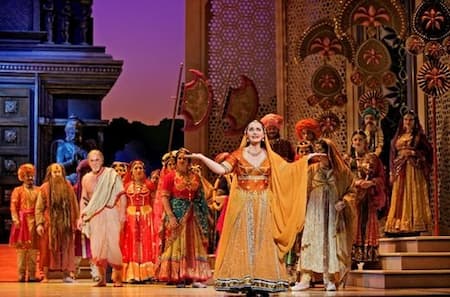
Lakmé (Opera Australia)
Léo Delibes: Lakmé – Act II: Ou va la jeune indoue, “Bell Song” (Maria Callas, soprano; Philharmonia Orchestra; Tullio Serafin, cond,)
Léo Delibes: Lakmé – Act II: Ou va la jeune indoue, “Bell Song” (Dilber, soprano; Estonia Opera Orchestra; Eri Klas, cond.)

Poster for the première of Lakmé
In this 8-minute work, the soprano is called on to imitate the crystal sound of the bells of the temple, doubled by the bells in the orchestra. In addition, holding a note with vibrato offers another challenge, as well the various solo sections where the singer is alone without the orchestra.
Léo Delibes: Lakmé – Act II: Ou va la jeune indoue, “Bell Song” (Joan Sutherland, soprano; Royal Opera House Orchestra, Covent Garden; Francesco Molinari-Pradelli, cond.)
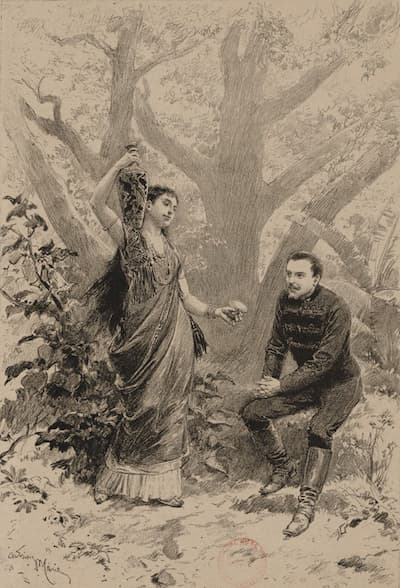
Lakmé, duo in the third act, by Adrien Marie, 1883 (Gallica-BnF)
Léo Delibes: Lakmé – Act II: Ou va la jeune indoue, “Bell Song” (Pretty Yende, soprano; RAI Symphony Orchestra, Turin; Marco Armiliato, cond.)
Sabine Devieilhe Sings the Bell Song in Delibes’ Lakmé
In the opera, the song is used to lure out a trespasser. Lakmé has fallen in love with Gérald. Her father, misunderstanding their love, thinks the English officer has affronted his daughter. He forces her to sing The Bell Song to bring out Gérald in the marketplace and when he appears, Lakmé’s father stabs him, though not fatally.
In Gounod’s Faust, as part of the planned seduction of Marguerite, Méphistophélès leaves jewels on her doorstep in the name of Faust. In her song Ah, je ris de me voir si belle (I laugh to see), Marguerite describes how, in looking at herself adorned in the earrings, she sees how they enhance her beauty: she is the daughter of the king!
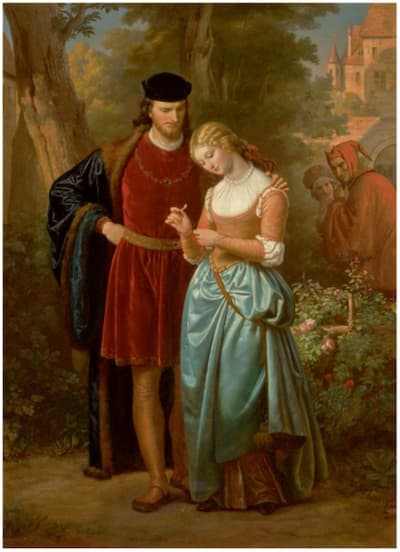
Eugen von Blaas: Faust and Marguerite in the Garden
Charles Gounod: Faust – Act III: Ah! Je ris de me voir si belle, “Air des bijoux, Jewel Song” (Karita Mattila, soprano; Philharmonia Orchestra; John Pritchard, cond)
Marguerite’s song is a beautiful Second Empire waltz, with a touch of the triangle to add sparkle to the melody. The role of Marguerite is difficult because of the range as emotions needed: starting as the young innocent, as in the Jewel Song, and then Faust’s lover, then a fervent churchgoer, the tragically abandoned lover, and, as in the case in too many operas, ends as the mad victim of Faust. One commentator in the 1970s said that only 4 sopranos could cover that range of emotion credibly: Lili Lehmann, Rosa Ponselle, Maria Callas and Montserrat Caballé.
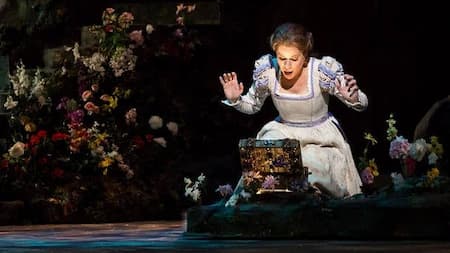
Marguerite discovering the jewels (Washington National Opera)
Charles Gounod: Faust – Act II: The Jewel Song: Les grandes seigners … Je ris de me voir si belle (Maria Callas, soprano; Paris Conservatoire Orchestra; Georges Prêtre, cond.)
The range of the part requires a lyric coloratura soprano, and Gounod’s writing is perfect for showing off that voice.
Charles Gounod: Faust – Act III: Ah! Je ris de me voir si belle, “Air des bijoux, Jewel Song” (Angela Gheorghiu, soprano; Torino Teatro Regio Orchestra; John Mauceri, cond.)
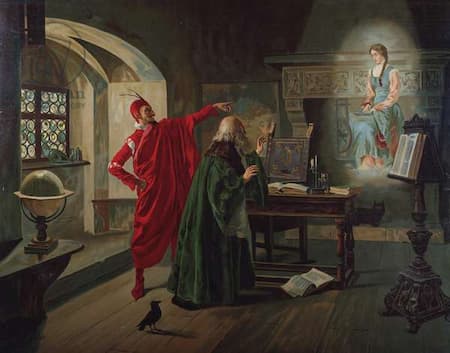
Fabio Cipolla: Méphistophélès showing Faust his image of Marguerite
The known difficulties of The Jewel Song made it perfect for parody. In the bande dessinée series TinTin, the cartoonist Hergé created the opera diva Bianca Castafiore, aka The Milanese Nightingale. Her first appearance in 1939 was changed in the 1950s to be more like Maria Callas. She’s characterized as being ‘narcissistic, whimsical, absent-minded, and talkative, and seems unaware that her voice is shrill and appallingly loud’. In various scenes in TinTin, her voice is enough to shatter glass, blow back the curtains on an opera box, and even to part Captain Haddock’s hair. The only song she is shown singing is The Jewel Song.

Bianca Castafiore’s first appearance in King Ottokar’s Sceptre, 1939 (© Hergé / Moulinsart 2022)
At each appearance, she becomes younger and younger. So do many opera singers….

Bianca Castafiore over time (© Hergé / Moulinsart 2022)
These bells and jewels for the soprano have maintained their places in the repertoire, even when their source operas left the repertoire for a few decades. Enjoy the high art – the art of the high voice.
For more of the best in classical music, sign up to our E-Newsletter



